AIR SPOTLIGHT
TRADE DEFICIT
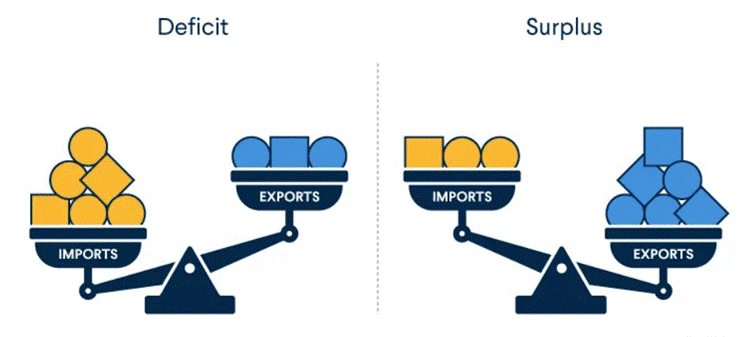
Disclaimer: Copyright infringement not intended.
Context
- If we go by the figures for April and May when it comes to trade data, the imports and exports the trade deficit has only gone up month on month and year on year.
- Having crossed a record $400 billion mark in 2021-22, India’s exports have moderated in the first quarter of 2022-23, with May and June clocking upticks of 20.6% and 16.8%, respectively, slowing from a 30.7% rise in April.
- Sequentially too, overall goods exports declined for the third month in a row in June, even as imports continued to rise sharply, triggering fresh peaks for India’s monthly trade deficit.
What is a trade deficit?
- Simply put, the trade “balance” of a country shows the difference between what it earns from its exports and what it pays for its imports. If this number is negative – that is, the total value of goods imported by a country is more than the total value of goods exported by that country – then it is referred to as a “trade deficit”. If India has a trade deficit with China, then China would necessarily have a “trade surplus” with India.
- A trade deficit signifies the lack of competitiveness of the domestic industry. The trade deficit of a country is due to a combination of various factors.
What are the principal reasons for to rise in trade deficits?
- When one looks at the trade deficit data it will only reflect the ability of a country to meet the gap over some time. These trade data pertain only to merchandise goods they do not cover service exports.
- So, whatever the trade deficit India may have to some extent it will impact the overall ability to meet the gap but that gap by large is more than made by India’s services exports.
- Hence, the catch in trade data is to look at both exports and imports segmentary in a different way. For example, exports growth decelerated - in May it was around 21% and in June it again came down to around 17%. Within the exports category, it is largely led by petroleum products and catalysts like engineering goods, yarn and plastic have seen a decline.
- Whereas imports during the same period out of the total there is a large segment of petroleum products once again. Out of total imports of $64 billion, $20 billion is accounted for petroleum products, another $6 billion accounted for coal imports, and $2 billion accounted for gold. So, these three big items actively skewed India’s import figures.
- Therefore, with decelerating exports, the rising import of three big items along with core imports (non-petroleum and non-gem) have also gone up and that growth is quite substantial which means that the domestic demand is quite good and strong. This reflects that Indians can maintain their purchasing power.
With rising imports, India has witnessed the depreciating Indian rupee against the dollar. How concerned is Central Bank about it?
- The depreciation of the rupee is a good thing for exports. Because once the rupee depreciates the exports become competitive. The depreciation also keeps a natural check on imports and exports.
- So, the depreciation of the rupee is a reflection of India’s domestic inflation rate and the demand for more dollars by the demand-supply mechanism.
- The Reserve Bank of India’ (RBI) intervention in the foreign exchange market is to avoid any kind of volatility or sharp depreciation of the rupee. Hence, the RBI is trying to calibrate the fall of the rupee and therefore, in the last few months RBI prompted dollars and India’s foreign exchange reserve has come down from $640 billion to $590 billion.
- RBI is also worried that this trade deficit might feed into the current account deficit (CAD) which may cause alarm bells. As the CAD is expected to further gone up from 2% to 3.1%.
- The government on the fiscal side also taking necessary steps to contain the deficit. The major reason for this deficit is the geopolitical issues that led to supply-chain disruptions and also an export ban on certain Indian commodities like wheat and steel (to contain domestic inflation), and export duty on petrol and diesel. These could also be the factors that led to deceleration in export.
It's not just a cess that has been imposed on petroleum products but also there is an increase in the customs duty on the import of gold.
Why gold has been always a contentious issue?
- Gold is an important product for the Indian communities. On an average of $2 billion per month, India spent on gold imports. Annually it would be $20-30 billion. This leads to two sets of problems:
- First, the capital spends on gold locked up for the long-term. As many Indians purchase gold as an investment.
- Second, regular imports increase pressure on the government and RBI as it has a huge impact on foreign exchange reserves.
- Hence, the gold imports need to be discouraged is a matter of debate. Whether only imposing a duty on gold import would be good enough or there should be other macroeconomic measures that need to be taken.
Gold is usually purchased by individuals in India to hedge against inflation. With the import of coal, petroleum and gold the depreciation of the rupee will continue. Measures need to contain not just inflation but also steps to ensure trade and convert the great deficit to a great surplus.
What steps are to be taken by the government to contain inflation and trade deficit?
- The government should focus on solving the root cause i.e., Much of this inflation is imported but that inflation itself spreads into retail inflation in the domestic economy. India’s inflation has risen to 7% recently and its comfort zone is 6%. The following measures could be taken to contain inflation:
- The government should make sure that the economy grows faster by increasing its capital expenditure.
- The government should start collecting more revenues. So, its overall borrowing limits should stay under control.
- It was expected that the government may increase its expenditure, and the government might borrow from the market. This borrowing will lead to an increase in inflation because the liquidity gets more assistance. Therefore, the government’s commitment to stick to the fiscal deficit signal that the government is very serious about controlling inflation.
Another alarming factor is about the finished goods are expensive for instance automobiles and electronic imports have also increased by 26.8%. Such imports have increased from $4.6 billion to $5.8 billion which is more than double the imports of gold.
How do these rising imports concern government?
- The imports are segmented as per the categories. India’s overall imports are grown up by 51% but the non-crude oil and non-gems and jewellery are up by only 32%.
- In other words, if non-crude and non-gem imports are rising daily it means the imported goods are going to the productive sectors of the economy. Many imported electronic goods are used as raw materials for finished goods which will be sold in the market and therefore will give a boost to economic activity. So, the government will not be concerned about it.
- What’s concerning is that the non-gold and non-crude imports grew by 32% whereas overall export has grown by only 16% of which non-gold and non-crude is just 5%. This mismatch needs to be handled by the government.
With India being a developing economy should give priority to its domestic inflation. The contained inflation will have a spill-over effect in various sectors of the economy. It will maintain purchasing power, which will maintain demand and will infuse supply and therefore will increase India’s GDP. Domestic production will decrease imports and increase exports in phases.
https://newsonair.gov.in/Spotlight.aspx#
https://t.me/+hJqMV1O0se03Njk9
NEWS IN BRIEF: PRELIMS SPECIAL
I2U2
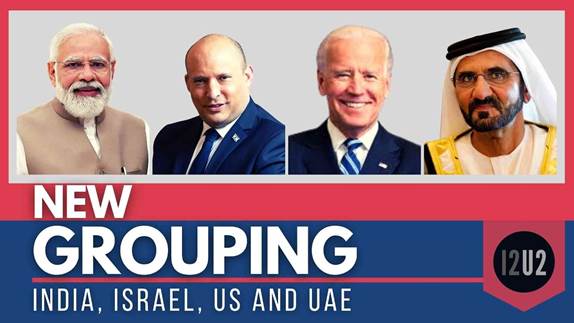
Disclaimer: Copyright infringement not intended.
Context
- Prime Minister Narendra Modi along with the Prime Minister of Israel, the President of the UAE and the President of the USA will participate in the First I2U2 (India-Israel-UAE-USA) virtually.
- The Leaders will discuss the possible joint projects within the framework of I2U2 as well as the other common areas of mutual interest to strengthen the economic partnership in trade and investment in the respective regions and beyond.
About I2U2
- On October 8, 2021, the foreign ministers of the four countries met and conceptualized this grouping – India, Israel, the US and the UAE.
- The grouping aims to work on joint investments in six mutually identified areas – Space, Health, Water, Energy, Food Security and Transportation.
- And the plan is to mobilize funds and expertise from the private sector which will help in promoting the development of critical emerging and green technologies, improving the infrastructure, low carbon development pathways for our industries, and public health.
https://newsonair.gov.in/News?title=PM-Modi-to-participate-in-First-I2U2-(India-Israel-UAE-USA)-leaders-Virtual-Summit-on-Thursday&id=444070
https://t.me/+hJqMV1O0se03Njk9
Baba Baidyanath
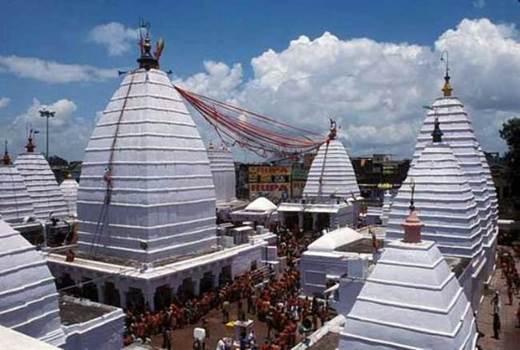
Disclaimer: Copyright infringement not intended.
Context
- The Prime minister Narendra Modi inaugurated and laid the foundation stone of various developmental projects worth more than Rs. 16,800 crores in Deoghar, Jharkhand.
- Among them was Deoghar airport which will lead to tremendous ease for devotees of Baba Baidyanath.
About Baba Baidyanath
- Baidyanath Jyotirlinga temple, also commonly referred to as the Baidyanath Dham, is one of the twelve Jyotirlinga in India and is considered to be the most sacred abodes of Lord Shiva.
- This temple is located in Deoghar, Jharkhand. Deoghar means ‘home of Gods’.
- Jyotirlinga means ‘column or pillar of light’. The ‘stambha’ symbol represents that there is no beginning or end.
- Along with Lord Shiva, Baidyanath temple pays homage to Maa Parvati as well. Therefore, it is unique in that it houses a Shiva Linga along with a Shakti Peetha like the Mallikarjuna Jyotirlinga at Srisailam, Andhra Pradesh.
- Baidyanath Dham has been famous since the rule of the last Gupta emperor, Adityasena Gupta in the 8th century AD.
- Mughal emperor Akbar’s brother-in-law built a pond at Deoghar known as Mansarovar. This temple appears to have maintained its importance even during the Muslim rule in India.
- Along with the main temple of Baba Baidyanath, there are also 21 other temples. Some of the shrines you will find here are Parvati, Ganesha, Brahma, Kalabhairav, Hanuman, Saraswati, Surya, Ram-Lakshman-Janaki, Ganga, Kali, Annapurna, and Lakshmi-Narayan. The Maa Parvati temple is tied to the Shiva temple with red sacred threads.
https://newsonair.gov.in/News?title=PM-Modi-inaugurates-Deoghar-Airport-in-Jharkhand%3b-Also-unveils-series-of-development-projects-over-Rs-16%2c000-crore&id=444043
https://t.me/+hJqMV1O0se03Njk9
National Conclave on Mines and Minerals
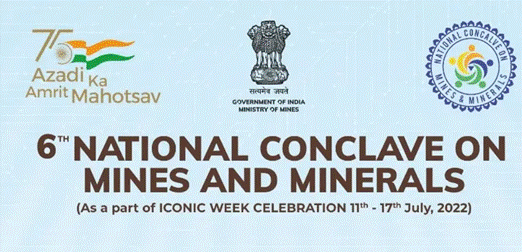
Disclaimer: Copyright infringement not intended.
Context
- The Union Minister for Mines Pralhad Joshi has inaugurated the 6th National Conclave on Mines and Minerals. The conclave has been organized as a part of Azadi ka Amrit Mahotsav.
Highlights of Conclave
- Conferring of national-level award Rashtriya Khanij Vikas Puraskar to the best performing States in the field of mining, the launch of three modules of Mining Tenement System (MTS), awards for 5-Star rated mines for the year 2020-21 and National Geo Science Awards-2019.
- Technical session by National Mineral Exploration Trust (NMET) and a session on automation in mining will be held as part of the inaugural session of the conclave.
- CEOs of various mining companies shall brainstorm on important issues about India’s mining sector during the round table discussions.
- The award function includes presenting new mine blocks to State Governments and the Ministry of Coal and providing an incentive to State Governments for successful auction and identification of blocks.
- Districts performing well under District Mineral Foundation Trust (DMF) will be showcasing their achievements.
- Digital kiosk showcasing exhibition on the development of exploration and mining during the last 75 years will be on display.
- A life-size digital booklet depicting reforms undertaken in the mining sector will be yet another attraction of the conclave.
About the Conclave
- Ministry of Mines introduced the concept of the National Mining Conclave in 2016 to provide a platform for interaction among different stakeholders like Central Government officers who are policymakers, state government officers, and the real executors in the auction regime, industry and the industry associations.
- The National Conclave on Mines & Minerals is reckoned as an overwhelming success in providing an effective platform to showcase key policy initiatives undertaken and help the Government in garnering valuable feedback for the sustained growth of the mineral sector.
https://newsonair.gov.in/News?title=Union-Minister-Pralhad-Joshi-inaugurates-6th-National-Conclave-on-Mines-and-Minerals%3b-stresses-on-Self-Reliance-in-Mining-Sector&id=444061
https://t.me/+hJqMV1O0se03Njk9
ICEMA’s Annual Session 2022

Disclaimer: Copyright infringement not intended.
Context
- The Road Transport and Highways Minister Nitin Gadkari address the Indian Construction Equipment Manufacturers’ Association’s Annual Session 2022.
- The Union Minister indicated that there should be an organisation for the Indian construction equipment manufacturing industry for research and giving appropriate technology for the future.
About ICEMA
- ICEMA is an apex association for construction equipment manufacturers in India and represents over 90+ leading companies that manufacture, trade and finance a wide range of Construction, Earthmoving, Concrete, Mining and Material handling equipment used in developing the robust world-class infrastructure for the nation.
- Constituted in 1949 as Tractor & Allied Equipment Manufacturers and Importers Association Ltd., the association started with 10 Indian member companies, primarily manufacturers and importers of tractors, earthmoving and allied equipment.
- ICEMA represents original equipment manufacturer OEMs covering 95% of the total construction equipment (CE) industry in India, apart from other leading companies who manufacture, trade and finance a variety of products including hydraulic excavators, wheel loaders, backhoe loaders, motor graders, vibratory compactors, cranes, dumpers, tippers, forklifts trucks, dozers, pavers, batching plants, diesel engines, etc.
- A key aspect of ICEMA’s work includes promotion of safety, setting of emission norms, technology integration & adoption, as well as continuous stakeholder engagement.
https://newsonair.gov.in/News?title=Union-Minister-Nitin-Gadkari-addresses-ICEMA%26%2339%3bs-Annual-Session-2022-in-New-Delhi&id=444082
1.png)
https://t.me/+hJqMV1O0se03Njk9
National Institute Ranking Framework (NIRF)
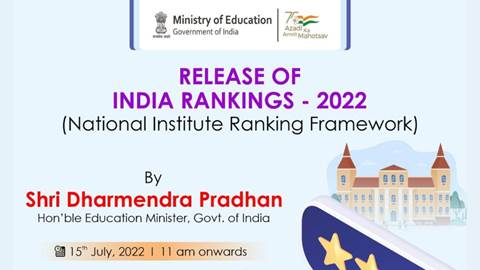
Disclaimer: Copyright infringement not intended.
Context
- The Union Education Minister Dharmendra Pradhan will be releasing Indian Rankings in 2022 under National Institute Ranking Framework (NIRF).
About NIRF
- The National Institutional Ranking Framework (NIRF) was approved by the MHRD and launched by the Honourable Minister of Human Resource Development on 29th September 2015.
- This framework outlines a methodology to rank institutions across the country.
- The methodology draws from the overall recommendations and broad understanding arrived at by a Core Committee set up by MHRD, to identify the broad parameters for ranking various universities and institutions.
- The parameters broadly cover “Teaching, Learning and Resources,” “Research and Professional Practices,” “Graduation Outcomes,” “Outreach and Inclusivity,” and “Perception”.
https://newsonair.gov.in/News?title=Union-Education-Minister-Dharmendra-Pradhan-will-release-India-Rankings-2022-under-(NIRF)-on-15th-July&id=444081
https://t.me/+hJqMV1O0se03Njk9









